
Astyanax is a genus of freshwater fish in the family Characidae of the order Characiformes. Some of these fish, like many of their relatives, are kept as aquarium pets and known collectively as tetras. With around 150 described species and new ones being described yearly, this genus is among the largest of the entire order; Hyphessobrycon also has more than 145 species and which one is larger at any one time depends on whether more species have been recently described in one or the other. The blind and colorless cave tetra of Mexico is a famous member of the genus, but its taxonomic position is disputed: Some recognize it as part of the Mexican tetra and this is supported by phylogenetic evidence, but others recognize the cave form as a separate species, A. jordani.

Carlastyanax aurocaudatus is a small species of freshwater fish in the family Characidae native to the Río Cauca in Colombia. It is the only member of the monotypic genus Carlastyanax, which was named in 1972 specifically for the species by Jacques Géry. Upon description, it was named Astyanax aurocaudatus by Carl H. Eigenmann. There has been debate concerning whether or not the genus should be recognized, but C. aurocaudatus is currently considered a valid species.
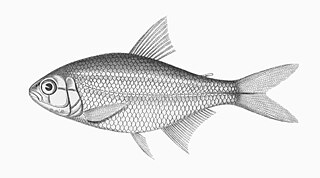
Astyanax argentatus is a small freshwater fish native to northern Central America and southern North America. Given its native range, it is also known as the Texan tetra. Little has been published regarding the feeding habits or behavior of A. argentatus, but it is known to have the northernmost distribution of any member of the genus Astyanax.
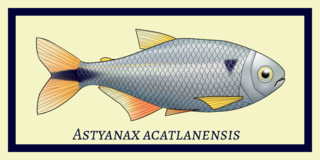
Astyanax acatlanensis, sometimes called the Acatlán tetra, is a small species of fish from the rivers of Mexico. It is a relatively hardy species that is able to tolerate a variety of water conditions, but is only found in freshwater, never brackish or marine. It is known only from the Río Acatlán, which is its type locality, and the Río Jía, which is a small, unknown river in the Oaxaca region.

Astyanax aeneus, the banded tetra, is a small species of fish native to southern Central America and northern South America. It can be found in a variety of environments, including lakes, rivers, ponds, and slightly brackish locales like lagoons. As well as a varied habitat, it has a varied omnivorous diet: algae, seeds, leaves, insects, and fish fry appear to be the most common.

Astyanax angustifrons, sometimes referred to as the Campeche tetra, is a small freshwater fish from the rivers of Central and South America. It has a healthy distribution across southern Mexico and northern Guatemala, and is relatively common within its native range. Details regarding its diet and behavior are sparse, but it lives in areas with plentiful riparian vegetation, and most other members of the genus are omnivorous. Its habitat includes places affected by pollution and human activity; nonetheless, it is not endangered.

Astyanax asuncionensis is a small species of freshwater fish described in 1972 from Asunción, the capital of Paraguay in South America. Its specific epithet is in reference to this. Currently, its range is known to encompass areas of not just Paraguay but also Argentina and Brazil. It is an adaptable, omnivorous species that easily lives in sympatry with various congeners.

Astyanax bacalarensis, sometimes referred to as the Bacalar tetra, is a small species of freshwater fish found in Central and South America. Its scientific and common names both refer to its type locality, Lake Bacalar in Mexico, and it further inhabits freshwater environments like cenotes, streams, and wetlands. Its widespread nature, paired with an omnivorous diet, make it a hardy species.
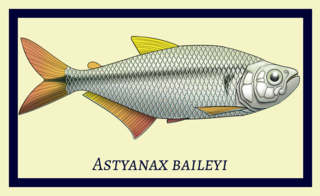
Astyanax baileyi is a small freshwater fish native to northern Guatemala. Based on several visual aspects, it was once considered a member of the genus Bramocharax, which is now obsolete, and has since been synonymized with Astyanax. As such, former members of Bramocharax are now a part of Astyanax, like Astyanax bransfordii and Astyanax caballeroi.
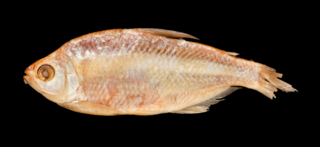
Astyanax belizianus is a small freshwater fish native to various regions of Central America. Little is known of its diet or specific environmental preferences, but it was first recorded in Belize. Modern ichthyology has expanded its range into Guatemala and Honduras, where it inhabits various rivers and lake tributaries. It is a silvery fish that may have a slight yellowish tint to its scales. The body is deep, especially in comparison to similar species from the same genus.

Astyanax boliviensis is a small species of fish native to a handful of rivers in northern Bolivia. Its scientific name is an allusion to its range, which includes the Candelaria, Madidi, and Mamoré rivers. Though it lacks a conservation status from the IUCN, a significant portion of its habitat is contained within the Madidi National Park, one of the largest protected regions in the world.

Astyanax bourgeti is a small species of freshwater fish native to the upper Amazon river in Brazil. Originally described in 1908, it is not a particularly well-studied member of the genus Astyanax, but there is enough information available to establish a native range, an appearance, and potential relationships to congeners; for example, A. bourgeti is a known member of the subgenus Poecilurichthys, and has been considered such for most of its existence. Biotope preferences, sympatry, diet, and behavior are all unknown.

Astyanax brachypterygium is a small species of freshwater fish endemic to a collection of high-elevation streams in Brazil. It was named in 2001 alongside congener Astyanax cremnobates, to which it bears a strong resemblance; physical details help to differentiate between the two. Its scales are a greenish-brown on the back and silver on the belly, with reddish fins and a dark humeral spot. One of its defining features is a notably short anal-fin base, which has 13 to 15 rays.
Astyanax bransfordii, sometimes called the longjaw tetra, is a small carnivorous species of fish endemic to a handful of lakes and slow-moving canals in Central America. Its range includes Lake Nicaragua and Lake Managua, which are two of the largest freshwater bodies in Central America; because it occurs only in the relevant areas of Costa Rica and Nicaragua, the area it actually inhabits is somewhat restricted. Its diet largely consists of various invertebrates and smaller fish. This is in contrast to various other species of Astyanax, which are more often omnivorous.
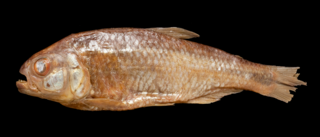
Astyanax brevimanus, sometimes referred to as the Quiché tetra, is a small species of freshwater fish native to various locales in Guatemala. Its native range is somewhat restricted, but it is a populous and adaptable species, so there is no risk of it going extinct anytime soon. It is unknown what A. brevimanus eats, or what specific habitats it prefers; current information is largely in the form of physical descriptions, general areas of occurrence, and hypotheses regarding relationships to congeners. Its silvery scales, indistinct humeral (shoulder) spot, and dark caudal-peduncle spot are features not unusual in species of Astyanax.

Astyanax brevirhinus is a small species of freshwater fish known only from a river basin in northeastern Brazil. It is somewhat understudied and lacks a conservation status, but it is present in a region that is the subject of an ecological restoration project - the Jequitinhonha River. Specifics of diet and behavior are unknown, though shoaling activity has been observed in laboratory conditions.

Astyanax caballeroi is a small species of freshwater fish endemic to a single lake system in Mexico. It has a longer snout and more slender body than most other species in the genus Astyanax, thought to be the result of predatory behavior; while A. caballeroi eats invertebrates and smaller fish, other Astyanax species are more broadly omnivorous, and have deeper bodies with shorter snouts. This difference in body shape once placed A. caballeroi, along with several other species of Astyanax, into the former genus Bramocharax.
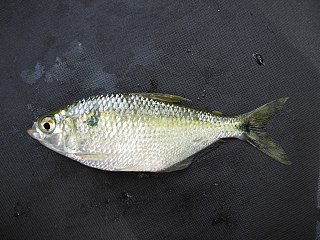
Astyanax caucanus is a small species of freshwater fish only found in Colombia. While little research exists regarding its ecological habits, such as diet and mating practices, its environment preferences are known to include marshy lowlands, and it easily lives in sympatry with various other fish species in the Cauca and Magdalena river basins. It is not known to share a habitat with any other species of Astyanax, but has a noted phyletic relationship to a group of congeners including Astyanax filiferus, Astyanax stilbe, and Astyanax magdalenae.

Deuterodon oyakawai is a small species of characin endemic to a large river basin along the Atlantic coast in southeast Brazil. It was originally one of three members of the genus Probolodus, but Probolodus is now considered obsolete, synonymized with Deuterodon. Much like other members of Deuterodon, and like some species in related genera, D. oyakawai is a small, silvery fish with fins in some combination of red and clear. It has a defined humeral spot that can be used for identification.
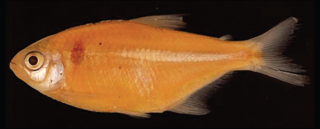
Deuterodon sazimai is a small freshwater fish endemic to a handful of river basins in southeastern Brazil. Upon being first described, it was considered a member of genus Probolodus; Probolodus is now considered obsolete, synonymized with Deuterodon. Much like other members of Deuterodon, and like some species in related genera like Astyanax or Jupiaba, D. oyakawai is a silvery fish with fins in some combination of red and clear. It sports a wedge-shaped humeral spot, and an oval-shaped blotch on its tail joint.




















